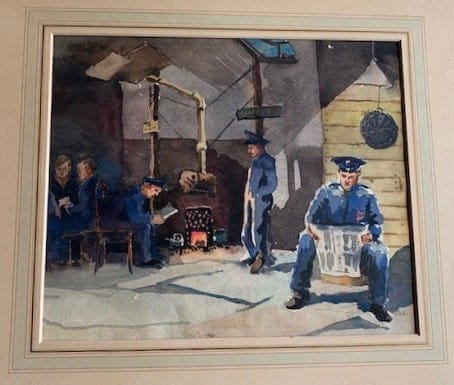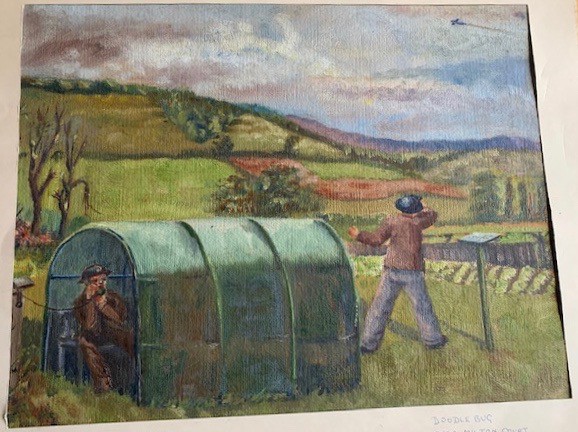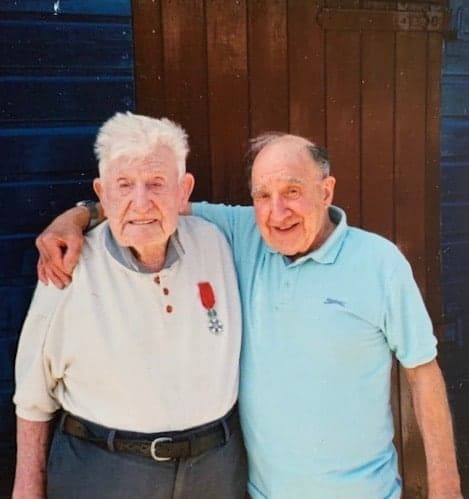
Photograph courtesy of Reg Rose
Reg was born on 11th December 1932, he lived in Westcott during the War.
Janet Deane and Cathy Firebrace interviewed Reg at his house on 18th February 2019.
| Time | Interview | Additional information |
|---|---|---|
| 0.32 | Janet introduces Reg and thanks him for contributing his memories of living in Westcott during the war. | |
| 1.03 | Reg starts with remembering exactly the day the war started. He explains that then the children either went to Sunday School at St. John’s Chapel or the church Holy Trinity, Westcott. All the villagers who lived in the actual village went to the chapel “We were in the chapel one Sunday morning, when all of a sudden we were sent home and war was declared.” |
|
| 1.42 | “So we all went home and I can remember listening to Mr Neville Chamberlain on the battery radio saying, “I have to tell you now, that no message has been received and no answer has been received, so therefore we are at war with Germany.” “ |
Recording of Neville Chamberlain’s speech |
| 2.07-2.33 | Interruption. | |
| 2.4 | Reg re-summarises listening to the speech on the radio. He says he can remember it as plain as anything. “The siren went and nothing happened for a bit. Then shortly afterwards my brother came home and began to dig a great big hole in our back garden. He lined it with tea chest panels, because tea was loose in those days and came in those chests” |
A tea chest is a wooden case with riveted metal edges originally for shipping tea. Now used when moving. |
| 3.27 | “The roof was a corrugated iron sheet. Then he put the earth he had dug out of the hole and made quite a descent shelter, but I don’t think we ever used it once” Reg laughs. |
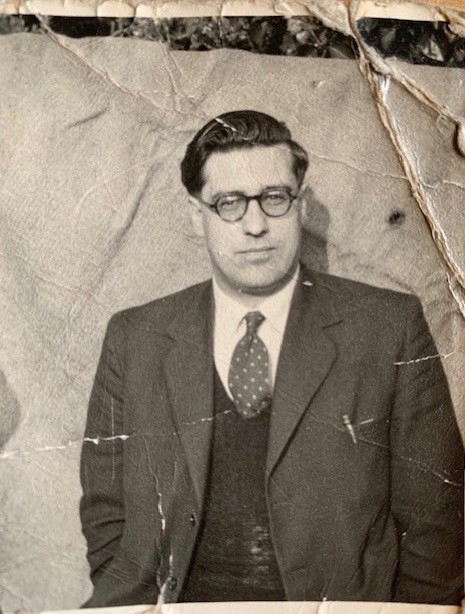
Photograph courtesy of Reg Rose
| 3.50 | It wasn’t very long before the night raids started. I remember clearly standing out in the dark watching the searchlights trying to find the enemy aircraft as they came towards London.” | |
|---|---|---|
| 4.11 | 1940 and 1941 were really terrible years.”The evacuees had already arrived by then and I remember them quite clearly coming down the road and the WRVS ladies sending them to their allocated billets. They all had labels on their coats. Most of them carried a small suitcase and a gas mask.” |
E. M. Forster and Ralph Vaughan Williams set up the Dorking and District Refugee Committee to help people fleeing Nazi Germany. Around 3,000 evacuee children from South London arrived at Dorking Station in September 1939. Read more on the Museum website |
| 04.44 | One of the evacuees became his friend. “Two doors down from me an evacuee was billeted and his name was John Tilley. He was at Dulwich Central School. They were quite an elderly couple so he was always around my place and we became good friends. He was really sharp.” |
BBC WW2 A People’s War – A Child’s War. Geoff Woolsey was brought up in Westcott and also remembers some of the evacuees |
| 05.11 | Reg compares himself and the other villagers to John who was always saying, “haven’t you heard of that?!” all the time. When he grew up, Reg says, John became one of the first computer experts and would lecture on computers. However, “in practical terms he was absolutely useless.” Reg explains that John wrote a book about British Rail: A Ticket To Tangiers. |
We have been unable to trace this book. John Tilley may have been Dr John Tilley (died March 2018 in Colchester), a lecturer in physics at Essex University from 1965. University of Essex Daily Blog April 2018. |
|---|---|---|
| 06.06 | Remembering the first fatality, Reg says it was “a chap called Herbie Smith. He was buried with full military honours at Westcott Cemetery. I can remember quite clearly the noise of the rifle shots as he was lowered into the grave. It was terrible. It was the first time I remember all the people coming from the village. All the ladies were dressed in black.” |
Herbie is Sidney Herbert Smith. Read his obituary on Westcott Local History Society’s WW2 Roll of Honour |
| 06.44 | Janet asks where the funeral was “In Westcott Holy Trinity.” She then asks where Reg lived in Westcott? “I lived in Bailey Road.” |
| 06.58 | All the people between 18 and 45 were conscripted into the forces straightaway. “The only exceptions were people who were doing important war work or were unfit for work. I can remember my brother when he was called up. He was much older than me. Another thing that sticks in my mind was them all scuttling around and getting ready for him to go off and I said to him, “Where do you have to go John?” and he said, “Cheerio Reg” and I said, “Where have you go to go to then?” and he said “Hadrians Camp Carlisle.” I can remember that as plain as anything.” |
The National Service (Armed Forces) Act September 1939, specified any male between 18 and 41 was liable to be conscripted and had to register. Hadrian’s Camp closed in 1969. Houses have now been built on the site. Read more of the history of the camp here. |
|---|---|---|
| 07.50 | He goes on to say he saw his brother twice in the next 5 years. He was sent to the Far East, which “was pretty grim. My Uncle Don, who had a colourful service, he was in the services as well.” | |
| 08.17 | Remembering starting school, Reg talks about Miss Gore who taught him to write with pen and ink. “Before that we’d all had a slate and we would learn by following the shape on the board and sound out the name of the letter.” | The BBC WW2 memories of Geoff Woolsey also mentions Miss Gore and other teachers. |
| 08.47 | He notes how hard it is to recall things in sequence. “The next thing that was really popular was a programme called ITMA : It’s That Man Again.” Reg sings the signature tune. He considers that all the characters were really part of a propaganda programme “to cheer you up. They worked the script round so they could get a Goering or a Ribbentrop in.” He notes there was one character he found particularly funny who had a Liverpool accent. He had never heard that accent before until one of the evacuees had that accent too. |
Hermann Goering and Joachim von Ribbentrop were both leading figures in the Nazi party. “It’s That Man Again” ran from 1939 – 1949 with Tommy Handley. It was a BBC comedy radio programme. |
| 10.04 | There was not much cheerful news going on, he thinks, so it made such programmes as ITMA seem more funny at the time. He adds that there was also Vera Lynn and Anne Shelton on the radio too. | |
| 10.46 | Quite often the electricity would go off рand you’d be sitting in the dark. In our place in Westcott we had a very old-fashioned fireplace. We all sat round, put the oil lamp on and listened to Tommy Handley and that was the way we spent the evenings. |
|
| 11.04 | “Things went on… I joined the cubs as soon as I could. The Akela there was a lady called Mrs Clinton. She was very smart. Her husband was the leader of the [ARM ?]- Mr Clinton – you will find his name in the books as one of the ARP leaders in the Dorking area. He was also the scout commisioner.” |
“A Brief History of Civil Defence” edited by Tim Essex-Liprosti gives a good overview of the ARP. Published by The Civil Defence Association, 2005. The Heritage Scouts website gives an account of life in WW2 |
| 11.40 | Mr Clinton’s son “was a highly decorated boy. He was a bomb disposal expert. He was twice highly commended with medals awarded him” “The war carried on. It was really grim. The next thing was rationing of course. Everything was rationed and as the war went on more and more were rationed. It was funny, because at the end of the war more things were rationed than at the start of the war!” |
|
| 12.33 | The Barclay family owned a big estate in Westcott. As the army moved into their house at Bury Hill, so the Barclays had to move out. The army then built Nissen huts right from Milton Court Bridge almost to the heath. “ There were 20 or 30 Nissen huts and going up the drive there were a whole series of units let into the bank which were storage units.” |
The Museum website has more detail on Bury Hill www.victorianweb.org gives the history of Milton Court. |
| 13.18 | Reg talks about the effect on Westcott village as everybody aged between 18 – 45 was called up. However, then the soldiers arrived “and there was a completely new lot! The thing they brought with them was there were always dances. The village had a dance every week and of course the girls got dolled up and the soldiers came and everyone had a good evening and would end up tipping the swill bins over at the end of each road. The bins would end up all upside down.” |
Swill bins were filled with scraps of excess food for the pigs and other livestock. Read more on the City Farmer |
| 14.09 | “The hut was really the centre of our life in the village at that time. The Westcott Players always put on a good play.” He goes on talk about particular players. “Also at the hut there was a room set aside where there were nice settees so the soldiers could come and sit quietly if they wanted, like a rest room which was nice.” |
|
|---|---|---|
| 14.55 | “There was bombing and all the things that go with war. We sort of got into a war mindset. When you see wars on television such as Iraq and you see children running around, that’s the kind of mindset you get when there is a war on.” | |
| 15.37 | Reg’s Father was a member of the Home Guard. “He had joined very early. He had been in the WW1; he was too old to go into WW2. He was the most easy-going person you could meet but he would always say “there’s only one good German and that’s a dead one.” That’s terrible now, but apart from that he was everybody’s friend.” |
Read more about the The Home Guard on the BBC website |
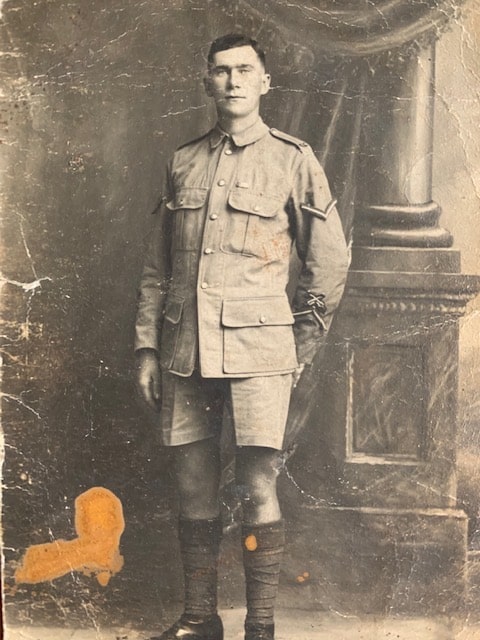
Photograph courtesy of Reg Rose
| 16.06 | “In the Home Guard he was the assistant armourer to Mr Sid Fuller who [ran] the fishing, gardening and cycle shop in South Street – his great grandson runs it now – . Every now and again Dad would bring me one of the old .303 Lee Enfield rifles home, because they weren’t issued with rifles right away. They didn’t even have uniforms to start with. When they got a bit more organised they had a few rifles and some of them were really crummy. Dad used to bring them home to me and I had my own set of linseed oil, a pull through and a 4 x 2 bandage. Not many people know what that is now. It was a sort of bandage shape 4 inches wide and a red line marking 2 inches. You would wrap this 4 x 2 around one end of the pull through, drop the pull through through the barrel and that was how you cleaned the barrel out. Some of the stocks were really rough. With the linseed oil youуd rub it down, get it into really good shape. Once Dad was satisfied the barrel was clean up to his expectations, weуd go into the front room and both lay on the floor and with an empty magazine, Dad would show me how to load, unload and fire this .303. I was only 7 at the time. He’d go on at me all the time how important it was to have a crisp movement of the hands. He used to say “don’t wobble it around like a wand”.” |
The S. C. Fuller website gives details of the history of the shop. Lee Enfield Rifles have more details of how to clean a rifle with a pull through. |
|---|
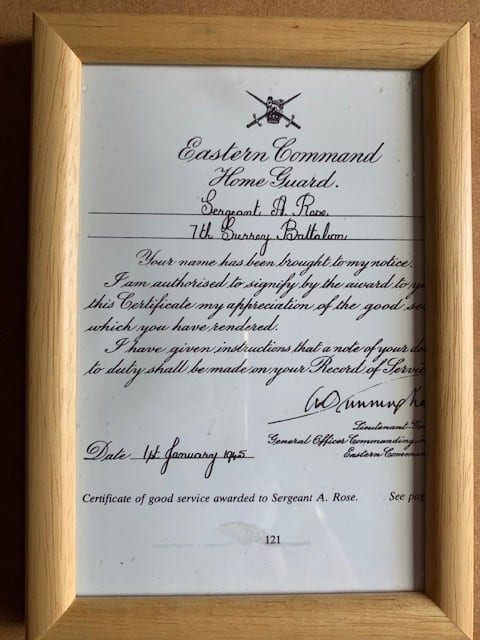
Photograph courtesy of Reg Rose
| 19.00 | Reg shows Janet an award. She describes the framed certificate from the Eastern Command Home Guard. Reg explains only two were issued and one of those was to his Dad. Janet reads it is dated 1st January 1945 “Your name has been brought to my notice. I am authorised to signify by the award to you of this certificate, my appreciation of the good service which you have rendered. I have given instructions that a note of your duty will be made on your record of service. Well done.“ Signed Dunning. Reg confirms that is the name. |
The book Home Guard List 1941: Eastern Command, War Office gives details of the units and officers. |
|---|---|---|
| 20.14 | The next thing Reg remembers is the jobs he and his fellow children did. “Because all the middle aged people were away, if you were 10 or 11 you most often were the eldest male person in the house. So you had to do all the jobs that Dads would do. That didn’t apply to me but I used to help other boys as well. Mums were left mostly on their own apart from a 10 year old and the younger children. They had to manage the best way they could. What made it much better was what was called Double Summer Time. So at night it was to aid the farmers at harvest time. At night we could do all our jobs. Every boy had a job in those days. When we had finished our jobs we would go down to the First Meadow and play football. That’s how the time passed.” |
|
| 21.48 | Reg says they often saw planes overhead during the Battle of Britain. “During that time in one particular afternoon there was a dog fight right over our roof. Mum and I hid behind the sofa. The English plane came really low across the top of our roof. I don’t know where it went after that. That was a really frightening time the Battle of Britain. The pilots of the Battle of Britain were like superstars. All the boys had a favourite pilot. Mine was a chap called Paddy Finucane. Never met him, never seen him but have read his book and he was killed during the war. He was my particular favourite. There was another one who was really good for propaganda. He was called Cats Eyes Cunningham. He was called that because he could see very well in the dark, because he ate tons and tons of carrots before he went on one of his missions. It all tied in with the propaganda machine. They wanted people to feed themselves.” |
Wing Commander Brendan Eamonn Fergos Finucane is remembered on The Battle of Britain London Monument. He was killed in action on 15th July 1942. Harpenden History website has a page on John Cats-Eyes Cunningham |

Photograph courtesy of Reg Rose
| 23.23 | Reg goes on to refer to Dig for Victory “Everyone tore up their flower gardens. Everywhere was planted with fruit and veg. Everybody had rabbits and chickens. I used to go with an older chap and we would go rabbiting on the hill with ferrets and nets. That was a real luxury if you had a couple of rabbits. Mum made a lovely rabbit stew. She had been in service when she was a young girl. She was a magic cook. She could make a really tasty meal out of anything. She used to tell me she had one afternoon off a fortnight in service.” |
|
|---|---|---|
| 24.52 | Janet asks if the allotments and home vegetables were adequate? Reg reminds us of the terrible loss of shipping during the war. The Government tried to make Britain as self- supporting with food as possible. “There were no bananas or oranges or any of that sort of thing.” Reg is distressed telling Janet about his Uncle Bill who had been in the navy and was drowned. “After that that was a rather poor experience for a while.” |
|
| 26.07 | He notes that of the children who all started school together with himself there were a few really tragic events. The older brother of Eddie Wheeler was killed. The elder brother of Alwyn Tucker was also killed. Reg’s uncle, his Father’s brother, was killed and the father of John Brooks was a prisoner of war. “So out of our little class you can see quite a few [bad] things happened.” |
|
| 26.43 | Reg considers that after Winston Churcill took over, which was only a few months into the war, things began to “settle down.” Reg remembers his stirring speeches. “After he took over people were a bit more optimistic. Things were still pretty rough. One of the things that still sticks in my mind was when a telegram boy came to the village. All the women would come out and stand by their front gates wondering where he was going to stop. Wondering where the bad news was going to be. Looking back on it, we as youngsters didn’t realise how dangerous it was. We used to run quite wild…. we used to run absolutely everywhere.” There were, he tells us, no fences back then or instructions not to go on private land. |
|
| 28.26 | Describing the rifle range at Whitedown, Reg talks about the troops who used to go there all the time to train. It was “right down the other end of Milton Court. We knew every blade of grass. Even the trees had names we gave them. I remember one was called the Blue Knee. Another was called the Forty Footer. In the sandrock which was right at the bottom of Coast Hill was a cave and very few people could get into it. You had to be really little.” Janet asks where Coast Hill is? He replies that it is between Westcott and Wotton, at the end of the common. “If you could get in it you’d be a real Westcotter.” |
Westcott Local History Group gives historical details and photographs of Coast Hill |
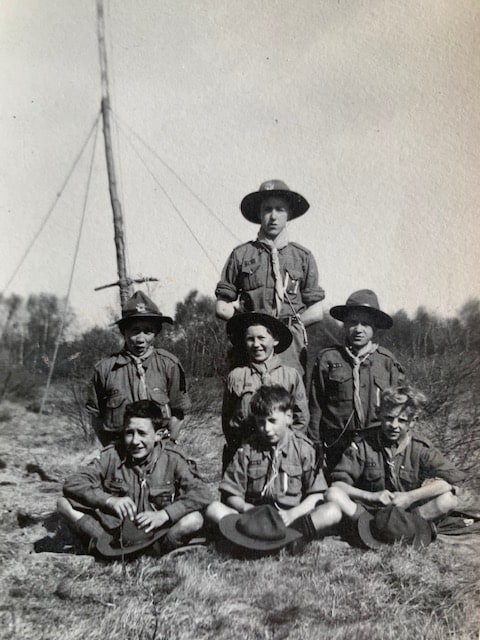
Troop Leader N. Judd
Back Row : Howell, Gatford, Taylor
Front Row : Reg Rose, Childs, Miles
Photograph Courtesy of Reg Rose
| 29.19 | As, in his opinion, things became a bit more organised Reg joined the Scouts which was to become a big part of his life. The scoutmaster, who was from London and had been transferred to Westcott, was “Mr Brewer. He was an artist and he drew these pictures.” Reg hands Janet the pictures. One watercolour she describes as being of the fire crew of Henley’s firm at Milton Court. Reg adds that he was told that before the war Mr Brewer “was one one of the Henley’s staffers. They would do the backdrops for Hitchcocks’ films when he first started as a film maker in England.” The picture is titled AFS Post by A L Brewer. |
W T Henley are manufacturers of electricity supply and distribution equipment and cables. Today they are a division of SICAME UK Ltd near Rochester. During the war the offices were moved from London to Milton Court.The costs of Radar and the Pluto oil line were worked out there and its factory in Kent did major secret work on the HAIS pipeline for the Pluto project. The Pluto project was the support for the allies invasion of France in June 1944 – D Day. Amongst the one time employees of the company was Alfred Hitchcock. He worked in their London based advertising department before making films. There is no mention of supplying backdrops. The BBC WW2 The People’s War When excitement became fear. Clifford Worth’s memories of becoming a junior clerk at WT Henleys and firewatching on the roof. In 1937, the government passed legislation enabling Auxiliary Fire Services (AFS) of volunteers to be formed as a support to the regular fire service in the event of war. |
|---|---|---|
| 31.43 | Reg goes on to talk about a doodlebug landing on a house miles away from any other property. It caught the apple tree which then fell on the house where two people were killed. It was near the driveway up from Milton Court going towards the railway line. He points out that it is where the vineyard is now. The 2nd picture is of the doodlebug. The people in it were the Henley’s staff part-time firemen, who “had a little metal hut by the fence.” When Mr Brewer died he left instructions that Reg was to have two of his paintings and Reg chose these. |
Read more on the Museum’s Wartime Incidents. |
| 33 – 33.28 | Pauses | |
| 33.29 | Continuing to talk about the Scouts Reg says, “We used to have our outdoor meetings at a place called The Barn, which was in Sir Norman [Touse’s] estate called Broomfield. The estate was split in two by Stones Lane. There was a nice walk over Stones Lane which connected the two properties. They had both, in their prime, been very grand. The Barn looked like two cottages which had interior walls taken out. It was ideal for Scouts, as it was dry, but there was no heating in there. With this lovely property you could do your leaf recognition. There were loads of specimen trees. |
Westcott Local History Group website gives details of Broomfield House and who lived there. There is mention of Sir Norman George Touche who was born 1888. His father died in 1935 and is buried at Holy Trinity Church Westcott. His son Gordon Touche left the house in 1956 and it was subsequently demolished for a housing development. |
| 34.41 | “One particular night.. we went to the top of Coast Hill to the glebe which was just near Wotton Church. We were in the hollow doing our bits and pieces as usual and all of a sudden a barrage balloon came over. An RAF plane came over. It did a couple of circuits. To the pilot it must have looked like there wasn’t a house or a soul for miles, apart from the church. It came round a third time and tried to shoot it down. The cannon shells from the plane ripped chunks out of the trees all around us. How anybody didn’t get killed I don’t know. The scoutmaster yelled at us to get down. That was really scary. If you went back 10 years after you’d still see great chunks out of the branches.” |
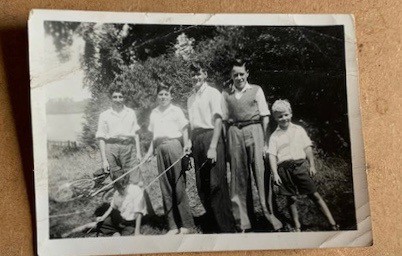
Reg Rose, R. Kempton, Mikey Croucher, F. McTigue, Kewington
Photograph courtesy of Reg Rose
| 36.05 | He goes on to talk about playing football in the Summer. Janet stops him to check that Double Summer Time means 2 hours forward. It is. So Reg continues to say that on the longest day it didn’t get dark until nearly midnight. They could therefore play quite late. |
|
|---|---|---|
| 36.55 | Another pastime in the Winter was sledging on the slope in First Brook Meadow. The aim “for boys of my age was to go down the slope, over the road and finish up in the shallow bit of the brook. There was only one boy who could do it, Geoff O’Donaghue as he had a proper sledge. The rest of us had bits of wood and trays. We used to do all sorts of things. I took the metal strips from the top of tea chests and would put those metal strips on my runners. I had the best runners in the place, but the borest sledge. I never got over the road.” |
A tea chest is a wooden case with riveted metal edges originally for shipping tea. Now used when moving. |
| 38.09 | Along that road, he says, was quite an interesting person who was killed in the war. “The First Brook Meadow finished at Westcott Street which was adjacent to Balchins Lane. Just round the corner on Balchins Lane was a house called Stowe Maries and that was where the famous film actor Leslie Howard lived. I used to deliver his papers.” |
Stowe Maries is a 16th Century Farmhouse in Westcott bought by Leslie Howard. It is in Balchins Lane. Read more on Wartime Stories |
| 38.53 | Janet checks with Reg that the daily newspapers went on as usual during the war. He confirms they did and there were more titles in those days such as The Chronicle and The Sketch. He refers to a magazine called “Everybody’s” which Reg thought was very popular. It was started and produced by “a chap called Greville Poke who lived at [Brooklyn] Farm. His wife was another famous actress called Patricia Lawrence. She was one of the ladies trapped in Singapore in the drama Tenko. He was also one of the star turns in the Westcott Players plays.” |
“Everybody’s” Weekly was a tabloid paper founded in 1913 as The Competitors Journal. It was taken over by Everybody’s Publications in the 1920s and ended in 1959. Patricia Lawrence was married to Greville Poke. She died in 1993. Greville Poke’s father founded The Competitors Journal and Greville was its editor until 1953. Greville Poke (died 2000) was also one of the founders of The English Stage Company. |
| 40.02 – 40.12 | Pause | |
| 40.17 | Janet comments that his everyday life was full. Reg confirms it was and refers to the Make Do and Mend campaign. “You never threw anything away. If you wanted to mend shoes you’d – and I have done this – cut a bit of cardboard if you had a hole in your shoe… If you had a hole in your kettle you had a pot mender, which was two washers, a screw and a nut. You’d put one each side and do up the nut and there’s your repaired kettle.” |
The Museum has a WW2 Loan box that can be borrowed. |
| 41.34 | “My Mum used to be really proud of her white sheets. She’d do sides to middle, but she used to spend about an hour hanging them on the line so the join wouldn’t show. The laundry was done in a copper which you lit a fire underneath and let the water boil. That’s how you got your hot water for the laundry.” Janet asks how long would it take to do a family’s laundry? “A long time. That was always done on a Monday and drying on a Wednesday. That was a regime most of my Mumуs age would follow. They used to get a bit of chalk from the hill and chalk the sill. They were very proud people. They were really poor. My Mum never had much to spare but would always put on a bright face.” |
Reg possibly means ironing on Wednesdays rather than drying. |
| 42.42 | Reg refers to another unique Westcott activity. “At the bottom of the [Baff Alley] – that was an alley that ran down at the side of our house – there was a little bridge that took you over the [Pippbrook]. There was just enough room for two people to lay side by side if you wanted to go fishing. There was a very strict regime. Most of us only had home made lines and hooks. So you both had your lines together at the same time and as you dropped the float into the water you’d shout “First cut” which [referred to] the line floating down under the bridge and into Judge [ Eastman’s], who lived at Westcott House. He had a really nice stocked pond, so if you let the float go down when it came out you were on Judge Eastman’s territory, but the trouble was if you caught a nice fish, it caused such a kerfuffle that you tangled the next bloke’s line. So most of us were fair when we pulled the line out and we’d let it get untangled”. Reg says that everybody in Westcott knew the “First Cut” rule. |
Westcott House is now a nursing home. |
| 44.51 | Janet asks if he ate the fish? “If you got a nice roach, yes. Coming down from the Rookery, which was the other side of the village, there were two pre-war lovely trout ponds and occasionally if there was a flood, a few trout would be washed down. So occasionally you got a trout.” |
|
| 45.26 | The brook played an important part in Westcott wartime life, he says. “Another rule was that if you hadn’t fallen into the brook or at least got your shoes and socks wet, you weren’t a Westcotter. At St. Johns Road, they all qualified because they’d dam the brook up and try to swim in it. The other people from Watson Road and Bailey Road we’d mostly qualify by trying to get the football out or pole-vaulted the wide bit . There can’t be many Westcotters now.” |
|
| 46.38 | Reg comments that they did not go into Dorking much. When they did he thinks “we must have caught the bus which was the 425 into Dorking West Street at the Congregational Church.” He thinks someone had organised a string concert. He would have been aged 9. “It was so crowded we had to sit on the floor. I remember being the so fed up I’d ever been. They were probably really lovely musicians, but they were certainly not in our league when we were used to Tommy Handley and Vera Lynn.” |
Dorking URC gives a brief history of the Congregational Church in Dorking. |
| 47.45 | A shop in Dorking he would like to visit was Cloud Craftу. Reg was keen on aeroplane modelling. The shop was down the end of the High Street. He could only buy gliders as it was not possible to buy rubber to drive the propellers. He hands Janet a photo of one of the Cloud Craft planes he made in, he thinks, 1943. She describes seeing a photo of a model aeroplane. Reg adds that you could only buy little bits of balsa wood and do the best that you could. |
Dorking Models in West Street carries on the tradition. |
| 49.05 | Reg says he has lots of photographs and hands Janet one of his evacuee friend John Tilley as a grown man. He kept in touch with John right until his friend’s death. John never went back to London. He tells a story about John when they were swimming “in the watermill which was a swimming pool by the Watermill Pub at the weir. We were sitting on the side when he said to me some fantastic figure and I asked what’s that? He said that was how much water there was in the pool. That’s what he was like. He came from Dulwich Central School in London.” |
The Wikipedia entry on the Pipp Brook mentions some of the watermill names round the Westcott area. |
| 50.40 | Another of the photos is of the celebration dinner for the standing down of the Dorking Home Guard at the end of the war. Janet describes the photo. | www.ww2today.com has a photo of a member of the Dorking Home Guard. |
| 51.15 | He thinks by 1943 or 1944 things started to be more optimistic. “There were funds launched for all kind of things. There was Wings for Victory week. One other thing they did was to go all around the village taking all the iron railings down from the side roads and Judge Eastman’s really big estate and Westcott House had iron railings all the way round, but they didn’t touch his and I thought that was really unfair, but they didn’t touch mine either” If you were an engineer you could appreciate it. They just came and ripped it down and some of it was really nice. The idea was they were going to melt it down for tank and aircraft production.” |
The Imperial War Museum War Industry: Wings for Victory, 1943 photographs. London Garden Trust So What Really Happened to Our Railings? |
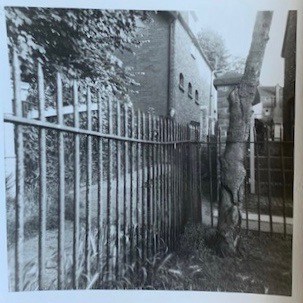
Sir Tom Eastman’s Stables in the background
Photograph courtesy of Reg Rose
| 52.41 | Reg goes back to thinking about Wings for Victory Week in Dorking. There was a children’s art exhibition and his school entered material. It was in a big room over Burtons in the High Street, “My picture of a Lysander hung there for the whole Wings for Victory week.” Reg won a prize for his picture. |
Westland Lysander was a light bomber plane. |
|---|---|---|
| 53.37 | He feels things were a bit more optimistic by the time of the war in North Africa. His Uncle Don was in the 7th Armoured Division. Reg reminds us they were called the Desert Rats and that they defeated Rommel who was known as the Desert Fox. Reg adds that his Uncle came home for a short while. “I think he thought his war was finished. Almost immediately he was sent to Kings Lynn. I remember him driving an army lorry all the way from Kings Lynn to Westcott to come and see us.” That was before his Uncle was sent to Northern Ireland to train for D Day. “He was in the group that went all the way through Europe. One of the first to reach a concentration camp. He met a Polish Jewish girl there. She was a prisoner. When they met he kept in touch with her and after the war she became my Auntie Janet. About three years ago he was made a Companion of the Legion of Honour by the French Government. I spoke to him last night and he is 104.” |
The French Government has been awarding the Legion d’honneur over several years to D Day Veterans from many different countries. |

Photograph courtesy of Reg Rose
| 56.43 | “My brother was just the opposite. He was sent to the Far East and for a long time my Mum didn’t know where he was. It was terrible really because they were called the Forgotten Army. It wasn’t until the film The Bridge on the River Kwai came out that people started to realise what they had gone through. It was amazing that up to that time nobody had given it a thought. One or two of them wrote disparaging books about the British Government and the way they had been treated. The Railwayman is one of them. They came home and nobody knew what they had been through. ” Reg is upset at this point in the interview. He continues” My Mum all of a sudden got a message that he was in the Viceregal Lodge in Shimla in the Himalayas. When he came he never said about anything at all. Over the years people learned that the Viceregal Lodge had been turned into a hospital for people coming back from Burma and India. He was always very careful about not taking his clothes off. I saw him once and he had his vest off. He had huge scars all over his back. That was really upsetting.” | The Forgotten Army of the Burma Campaign from the Military Times The Bridge over the River Kwai was made in 1957. The Railwayman is a book by Eric Lomax giving his account of his time in Burma. www.shimlaindiaguide.com gives details of the Viceregal Lodge. |
|---|---|---|
| 59.05 | Reg talks more about how he and his wife travelled to Thailand, Vietnam and Cambodia and how the impact of the troops experiences there during the WW2 continued to have an emotional impact on visitors. |
| 1.00.21 | Janet asks whether, when he was living in Wescott, he was aware of the preparations for D Day? He replies no he wasn’t. He can remember a big build up of troops. “There were tents in the Second Brook Meadow.” Janet enquires more about the name of the meadow. Reg explains that at Westcott there were two large fields. They were joined together by a little track where Mr [Bonwick] would bring his milk cows from Milton Court through the track from the Second Brook Meadow to the First Brook Meadow to the dairy which stood at the bottom of Westcott Street. |
www.thechurchinwestcott.org.uk – Westcott Village Magazine October 2018 pp 74-75, has an article on the history of Westcott Dairy and who owned it during the war. |
|---|---|---|
| 1.01.40 | Reg’s Dad had quite a large garden and he would grow carrots. In-between the carrots he would grow parsley as parsley keeps the carrot fly off. He describes how the Second Brook Meadow has a dip in it which would, at certain times of year, collect water in it allowing watercress to grow there which his mother would use. He describes how he would also go to the “eye glasses on the side of the hill. There is a wood the shape of an eye glass. I never told anybody at all, but my Dad told me where it was. I used to go up there and there was a tree there that was ideal for garnish. I used to take off a few leaves at a time.” Reg could not recall the species of the tree at that moment. |
|
| 1.03.31 | As his father had quite a big garden, but was often busy with the Home Guard, he would let bits off as allotments. | |
| 1.03.59 | There was sad news when a bomb landed in Watson Road. “There were four cottages down the very bottom. A bomb landed right on top of it. Nine people were killed. If it had gone 25 yards the other way it would have been in open countryside. Two of the people killed were Freddy Williams and John Bird. They were evacuees. They’d been evacuated from London to the safety of Westcott and they were killed. They were the same age as me so I went to school with them.” He lists the other families killed. |
www.sussexhistoryforum.co.uk has articles on the bomb on Watson Road 5th January 1944. It gives names of the victims and further details. There is a memorial to them in Holy Trinity Church, Westcott |
| 1.05.08 | “The thing I remember most about it. It was only about 50 yards away from where I lived. I went down there in the morning and the air raid shelter which was 25 yards away from the house, it had been all lifted up and it had been moved a foot. It had been lifted off its base and plonked back down again. It stayed more in my mind than the building. It was incredible. It hadn’t crumbled.” |
| 1.05.48 | Reg continues to recall bombing. “There was another bomb that landed in [Judge Eastman’s] estate. That time I was in bed and it had knocked half of my bedroom ceiling down. That came down on top of me. Ours was a very old house and it was all lath and plaster. It was all horsehair. It was really, really filthy. There was a unit – a bomb repair unit – who came and fixed it up… My Dad was so busy. I had half a white ceiling and half a brown ceiling for the next 15 years.” |
|---|
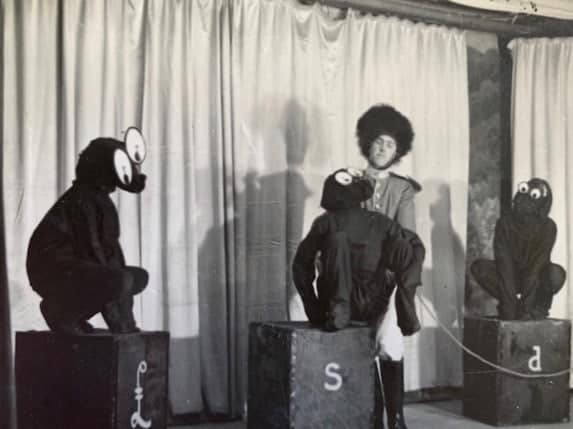
Officer in Charge – N. Jupp.
Dogs L-R Reg Rose G. Batford C. Miles.
Photograph courtesy of Reg Rose
| 1.07.05 | Reg mentions again that it is hard to remember all the happenings in the right order. He notes also that as the war went on people started to do different things again. “Skipper Brewer was a real showman. We put on a few shows in local village halls. He wrote “The Magic Tinder Box”. It started in 1945 and we were still doing it in 1947.” Reg has a copy. Janet describes the 17th District Westcott Scout Group Souvenir booklet. There is a picture of Reg dressed up as a dog using blackout material. |
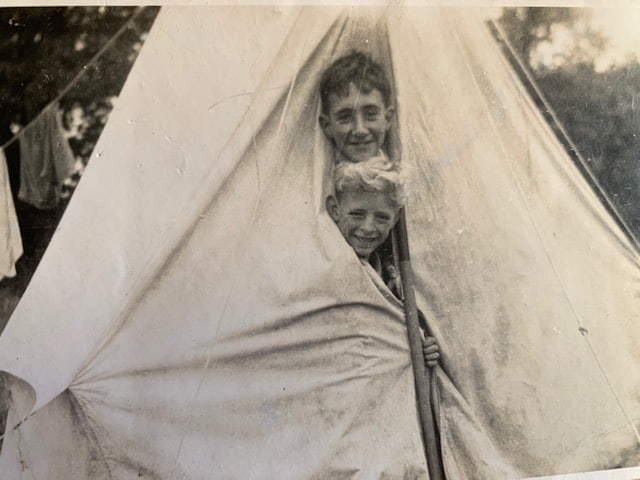
Photograph courtesy of Reg Rose
| 1.09.07 | Janet asks if he can remember the end of the war? He replies that he does. “You weren’t officially allowed to pitch a tent as a scout until the war had finished in May. However, Colonel Barclay, who owned virtually all of the ground from Westcott to Coldharbour, gave us permission to have a test camp at Upper Meriden. We had all our gear in the old Westcott Fire Station – we called it the den. We got an old bell tent out. There was only a few of us as some Mums wouldn’t let them go. We went up to Meriden and camped. Colonel Barclay arranged for us to pick some milk up at the cottage and arranged for one of the woodmen to drop off a load of wood for us. We stayed 2 nights under the bell tent. It was like being under barbed wire!” |
|
| 1.10.40 | Janet asks him where Meriden is? Reg says it is at the end of Logmore Lane. “Later in the year there was VE Day and there were big celebrations. First a street party in every road and then a really big celebration on the common – Westcott Heath is the official name for it… Mr Brewer was an expert on bonfires. He arranged the village bonfire. He made a really, really big one.” Reg helped Mr Shepherd, the electrician to fix up floodlighting. “People were dancing until 2.00 in the morning” | There is an Upper Meriden Cottage in Abinger forest |
| 1.12.02 | “As we had done our experiments with camping, we were allowed to have a Summer Camp at a place called Sidlesham, which is in Sussex. While we were there it was VJ Day. Mr Brewer organised another huge bonfire.” The local farmer helped them and local villagers came. Reg continues, “The proprietor of the pub arranged for crisps and lemonade for the scouts and we all had a lovely evening.” Reg ends with a humorous story about returning a couple of years ago to find if the pub was still there. | |
| 1.14.53 | The interview ends with thanks to Reg. |


